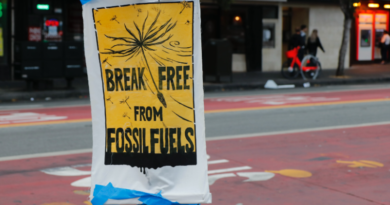Green finance: banks’ climate pledges undermined by woolly definitions
What makes a project “green”? In cases such as wind farms, the answer is obvious. Other definitions can be woolly. A bank might extend climate finance to a sheep farm if it follows certain “sustainable” farming practices, for instance.
After years of criticism from environmental groups, more banks are setting green or sustainable lending targets. But definitions of what projects or companies can qualify are often stretchy. That could easily turn the initiatives into case studies in greenwashing.
Sustainable finance has a broad definition. It includes green bonds, where funds raised go towards environmental or climate-related projects. Other instruments, such as derivatives or business loans used for similar purposes, also count.
Ireland’s AIB Group said this week it would triple the money allocated to a climate fund to €30bn. It aims for 70 percent of all new lending to go to green or “transition” projects by 2030. This is a global trend: the top 24 European and US banks have set out sustainable finance targets that collectively amount to €15 trillion by 2030, according to research from the consultancy Alvarez & Marsal (A&M). Large European banks account for two-thirds of that sum.
On first sight, AIB’s 70 percent new lending target looks ambitious. Out of total new lending of €12.6bn last year, €3.3bn, or 26 percent, was green finance. Including transition finance in its calculations should make AIB’s job easier.
Banks’ definitions of transition finance—wwhich vary wildly—hhave come under attack from environmental campaigners, though. They can include funding for polluting companies.
In state-backed AIB’s case, companies that could qualify for transition funding might include a telecoms group if it deals in teleconferencing software. A breeding cattle farm could potentially qualify if it buys cows that have a better profitability rating. The bank acknowledges it may need to revisit transition criteria as “global definitions evolve.”.
“While some banks have a sustainable finance fund, which could be broader, what we have announced is a green and transition fund,” AIB said.
Other areas are more straightforward. Green mortgages were a particularly strong area of AIB’s green finance growth in 2022. Here, banks offer cheaper loans for the purchase of homes with high energy efficiency ratings—ooften new-build properties.
Green mortgages should continue to provide growth, even if a decline in property lending means overall new loans are likely to dip this year to about €9.5bn, according to Davy analyst Diarmaid Sheridan.
The state-backed AIB was an early adopter of a sustainability agenda. Others are catching up, but comparisons are difficult, says Fernando de la Mora, co-lead of A&M’s global financial services practice.
Sustainable financing targets can be defined in different ways with varying time horizons, he points out. Some banks also include social projects and businesses rather than just a climate focus.
Crucially, just two of the top 24 European and US banks report the revenue potential of sustainable finance, as A&M’s data shows. “Very few banks are converting this into an equity story,” adds de la Mora.
This is perhaps the biggest oversight. For green finance initiatives to stick, banks need to prove to investors that they are more than just a promotional exercise.
To green or not to green?
Borrowing dulls the edge of husbandry, as Polonius advised in Shakespeare’s Hamlet. Italian utility Enel is seemingly heeding the old courtier’s advice.
Under its former chief executive, Francesco Starace, Enel expanded into one of the world’s largest renewables producers. But it racked up debt of €60bn along the way. The new broom, Flavio Cattaneo, now rightly insists it must live within its means.
The change in tack is understandable. In 2022, state-backed Enel found itself buffeted by rising interest rates, just as higher commodity costs took a chunk out of its margins. Investors dropped the stock like hot coals. Starace was forced to draw up a €21 billion asset disposal programme before he was replaced by Cattaneo earlier this year.
The state-backed utility reckons more than €17bn of that target is already in the bag. Its tally includes deals completed or in advanced stages of negotiation.
Cattaneo now wants to limit borrowings. Enel will trim capital expenditures and fund more of its growth through grants. It also aims to bring third-party renewable energy developers into its projects. That will cut net capital expenditure from €11.5bn, envisaged under the group’s previous plans, to less than €9bn per year between 2024 and 2026.
In practice, this will mean some 60 percent of net capex will go into building out grids. These tend to have predictable, regulated returns. Enel will veer away from building renewables in Latin America, where risk-adjusted returns are challenging. Instead, it will focus on Spain and Italy. Here, it has customers to hedge its production.
The last leg of Enel’s plan is to cut €1.2 billion in costs. That has allowed it to juice up its targets for earnings before interest tax, depreciation, and amortisation (ebitda). It also means that net debt will decline from over 3 times to just 2.3 times ebitda by 2026. The new Enel looks much more like an old-style utility than a pioneering investor in renewables.
Yet, for investors, a narrowing of the utility’s ambition is a consolation. Enel’s stock still trades at less than seven times this year’s ebitda. Rival Iberdrola gets a 30 percent premium. Cattaneo’s plans should help narrow the gap.
Source : ft.com




